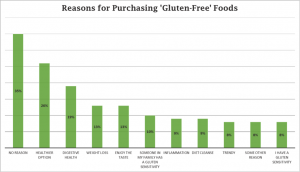Why are we so hung up on the gluten-free diet?
The gluten-free diet craze
Have you ever stopped to wonder why the gluten-free diet has become one of the most popular diets in the United States?
Claims have been made that gluten-free diets can help you lose weight and improve overall health and exercise performance (1). Even a wide range of books, magazines, and TV shows indicate a correlation between gluten ingestion and a multitude of health concerns (1). The research to back these claims? None.
Yet, the findings of a 2015 survey (figure 1) are astonishing. Over 50% of the 1,500+ American adults who completed the survey, purchase gluten-free foods for either “no reason”, or because they believe it to be a “healthier option” (2).

Figure 1 Results from a 2015 survey of more than 1500 American adults explaining the reasoning behind selecting gluten-free foods (7)
Is your diet free of just gluten?
Just by its name, one can presume a gluten-free diet is, in fact, free of gluten. Yet, if gluten is tossed out the window, are other important nutrients to follow?
A growing body of evidence (1, 3, 4, 5) suggests nutritional inadequacies among those following a gluten-free diet. This diet excludes gluten-containing foods that are major sources of energy, carbohydrates, iron, calcium, zinc, magnesium, and B vitamins (6) and replaces them with excessive amounts of fat (4) and sugar (5, 7).
A recent case-control, cross-sectional study, published in the Journal of Pediatric Gastroenterology and Nutrition, contributes to this growing body of evidence by showing a more unbalanced diet in participants with celiac disease than control participants in terms of added sugars, total fat, and micronutrient consumption (6).
Norelle Reilly, a MD from the Division of Pediatric Gastroenterology at Columbia University Medical Center, explains, “…apart from the treatment of specific disease or symptoms, [a gluten-free diet] may carry more risk than benefit for children” (3).
What if You or Your Child Has Celiac Disease?
If you or your child has celiac disease, the only current treatment is strict gluten avoidance (1). The following table summarizes the potential outcomes of a gluten-free diet. Although there are disadvantages and risks, proper guidance from a registered dietitian can help foster a healthy and balanced diet, rich in vitamins and minerals.
Summary of potential gluten-free diet outcomes (3)

If a gluten-free diet is the right fit for you or your child, the following tips and kid-friendly gluten-free recipes can be of help.
Helpful Tips and Gluten-Free Recipes for Children and Families
- For those picky eaters who gravitate towards white rice, try mixing in some millet.
- Try quinoa, or if you are really feeling adventurous, try buckwheat!
- Build strong and healthy bones by adding protein, calcium, magnesium and potassium to your diet with greek yogurt. Check out these fun recipes your family will love.
- Let your child help wash and prepare vegetables. They will be more willing to try them—and may even like them!
- Try gluten-free banana walnut oat waffles for a Sunday morning special treat.
- Gluten-free oats and a nut butter can be used to make zinc and iron-rich Oat Balls or Energy Bars
- On a budget? Use frozen instead of fresh fruit and vegetables to create a deliciously nutritious smoothie for you and your child.
For additional gluten-free recipes, visit http://melissashealthyliving.com/category/recipes/gluten-free/
Final Thoughts and Reminders
- Go for the naturally gluten-free grains, such as millet, quinoa, and buckwheat, for its fiber and energy content to promote a healthy gut and immune system.
- In addition to avoiding gluten, focus on promoting a balanced and healthy diet.
- Seek advice from a registered dietitian or health professional to ensure your gluten-free diet is not lacking in important nutrients.
Focus on what you can eat rather than what you can’t eat.
References
- Babio N, et al. Patients with Celiac Disease Reported Higher Consumption of Added Sugar and Total Fat Than Healthy Individuals. Journal of Pediatric Gastroenterology and Nutrition. 2017;64(1), 63-69.
- Reilly NR. The Gluten-Free Diet: Recognizing Fact, Fiction, and Fad. Journal of Pediatrics. 2016; 175, 206-208.
- Newberry C, McKnight L, Sarav M, Pickett-Blakely O. Going Gluten-Free: the history and nutritional implications of today’s most popular diet. Curr Gastroenterol Rep. 2017; 19: 54.
- Kulai T, Rashid M. Assessment of nutritional adequacy of packaged gluten-free food products. Can J Diet Pract Res. 2014; 75: 186-190.
- Wild D, Robins GG, Burley VJ, Howdle PD. Evidence of high sugar intake, and low fibre and mineral intake, in the gluten-free diet. Aliment Pharmacol Ther. 2010; 32: 573-581
- Zuccotti G, Fabiano V, Dilillo D, Picca M, Cravidi C, Brambilla P. Intakes of nutrients in Italian children with celiac disease and the role of commercially available gluten-free products. J Hum Nutr Diet. 2013; 26: 436-444
- Becker B. Gluten Free Trend. www.hartman-group.com/hartbeat-acumen/120/gluten-free-trend. Updated September 3, 2015. Accessed February 16, 2018.
- Nutrient Recommendations: Dietary Reference Intakes (DRI). National Institutes of Health. 2011. Available at: https://ods.od.nih.gov/Health_Information/Dietary_Reference_Intakes.aspx. Accessed February 16, 2018.
Written by Nicole Lindel ~ Nutrition Education Master’s Student at Columbia University
